
Fall for Ginkgo: Golden Leaves and Tasty Treats
Written by Team MUSUBI
With summers stretching a bit longer each year, the anticipation for autumn grows stronger. But it’s not just the cooler breezes and longer nights that make this season so eagerly awaited. Autumn in Japan is when the landscape bursts into warm, fiery colors as the leaves begin to change.
And when it comes to making you feel like fall has truly arrived, the ginkgo tree steals the show. These brilliant yellow trees are impossible to miss—especially when you’re walking through a blanket of their leaves. Get ready to discover another charm of fall in Japan with everything ginkgo, from its eye-catching colors and distinctly defined foliage to its famously funky (but surprisingly tasty) fruit—a true treat of the season. We’ve rolled out the golden ginkgo carpet just for you.
table of contents
The Ginkgo Tree: A Living Fossil

The ginkgo tree, known as icho in Japanese, is often referred to as a “living fossil” due to its origins dating back over 200 million years to prehistoric times. While most of its species went extinct, the ginkgo endured through the ages. Veiled in mystery regarding how and when it arrived in Japan, many theories suggest it was introduced from China. Interestingly, written mentions of icho only began to appear in poetry during the Edo period (1603 CE–1868 CE).
You can often find ginkgo trees near temples and shrines, where they symbolize endurance and longevity. This resilience is no surprise, as the ginkgo has survived multiple extinction events and natural disasters, such as the famous ginkgo at Tsurugaoka Hachimangu Shrine in Kamakura, which regenerated after being uprooted by a typhoon in 2010.
Autumn’s Golden Glow: The Ginkgo’s Transformation

When autumn sweeps across Japan, the vibrant yellow leaves of the ginkgo tree create a stunning visual spectacle. But what causes this golden transformation?
The yellow hue comes from the pigments called carotenoids, which remain as chlorophyll (the green pigment) breaks down with the shorter days and cooler temperatures. The unique yellow is particularly striking because it is often one of the last trees to fully turn in the autumn. While many other trees sport a mix of colors, the icho’s leaves turn a uniform, brilliant gold, creating a mesmerizing canopy that blankets streets, parks, and temples.
The Iconic Fan-Shaped Leaves

One of the most recognizable features of the ginkgo tree is its distinct fan-shaped leaves. Unlike the intricate lobes or points of other trees’ leaves, ginkgo leaves are simple and symmetrical. While you may notice a slight variation in the cuts at the top, the leaves are almost identical in shape. This signature shape, combined with their dense clustering, adds to the overall aesthetic appeal. But it’s not just their appearance that’s fascinating; the leaves also have a unique evolutionary story. As the ginkgo tree evolved millions of years ago, its leaves adapted to absorb sunlight more efficiently, with a broad surface that maximizes exposure. Even today, this shape remains a defining element of the ginkgo’s charm, giving them a timeless, almost unearthly presence.
Interesting Fact: The ginkgo leaf is so iconic that it even serves as a symbol of Tokyo. The official emblem of the Tokyo Metropolis consists of three arcs resembling a ginkgo leaf, designed to represent the letter "T" for Tokyo. The logo is typically rendered in a vivid green color to symbolize Tokyo's future growth, charm, and tranquility. This emblem was officially adopted on June 1, 1989, further solidifying the ginkgo leaf as a powerful and enduring symbol in Japanese culture.
Ginnan: The Culinary Delight of Ginkgo Nuts
Despite their pungent exterior, ginnan are a prized seasonal delicacy. Slightly nutty in flavor and soft in texture, when in season, they are a delight in chawanmushi, steamed egg custard, and make a perfect snack to accompany sake when roasted with a dash of salt. As autumn deepens, you'll find mesh bags filled with cleaned ginkgo nuts lining store shelves. To remove the shell, gently tap the nut with a hammer, rolling pin, or nutcracker. Then peel away the paper-thin membrane with your fingers, blanch or pan-fry them for a few seconds.

Among the various ginnan varieties, Tokuro is one of the largest and most flavorful. Known for its size—about twice that of a regular ginkgo nut—Tokuro nuts have a thin shell and a beautiful, pale white hue, making them a popular choice. Their chewy, satisfying texture and subtle flavor make them a seasonal delight, cherished for their unique taste and versatility in Japanese cuisine.
As 2024’s autumn season arrives later than usual, there’s still time to experience the magnificence of Japan’s icho trees in all their golden glory. Whether you’re drawn to their striking appearance or curious about the unique culinary experience of ginnan, the ginkgo tree offers a fascinating insight into Japan’s natural beauty and seasonal traditions. Be sure to take a stroll under their glowing canopies and, if you’re feeling adventurous, sample one of Japan’s most intriguing seasonal delights.







Leave a comment
This site is protected by hCaptcha and the hCaptcha Privacy Policy and Terms of Service apply.